BE AFRAID… BE VERY AFRAID…. The Cinema of Horror
Archive Posters at the Rick Nicita Gallery
This month, the Rick Nicita Gallery space in the Center for Film Studies opened an exhibit of horror film posters from the Wesleyan Film Archive. This show coincides with the Cinema of Horror class that I’m teaching this semester, and so I wrote up a brief discussion of the genre and its advertising, which I’m posting here. The Gallery is open Fridays and Saturdays 12 – 4pm.
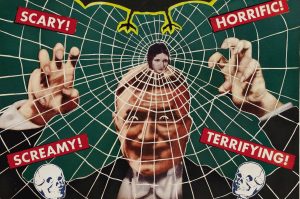
Horror began creeping into cinema in 1896 when George Méliès directed his trick film The House of the Devil. It haunted 1920s Germany in expressionist masterpieces like The Cabinet of Dr. Caligari and Nosferatu. The term “horror film,” however, first appeared in 1932 during the great plague of Hollywood monster movies touched off by Universal Studios with Dracula a year before. The genre has stalked our screens ever since, with outbreaks cropping up in the 1950s, late 1960s, mid 1980s, late 1990s and an unrelenting apocalyptic siege encouraged by digital distribution over the past decade. There is no escape.

For young filmmakers, horror films offer a primer on how to play with expectations and move viewers with image and sound. The genre thrives at lower budgets, encourages flamboyant style, needs no stars, and tends to be critic-proof. As genre built on suggestion, horror also has long been a vehicle for social commentary. Caligari (1919) refracted the trauma of WWI, Night of the Living Dead (1968) repurposed imagery from the Vietnam War, and Get Out (2017) documents American racism. Horror movies can deal with subjects otherwise reserved for somber “issue films,” and they reach huge audiences along the way.
Most of us, though, go to horror films to be scared, and producers are more than happy to oblige. The posters here all guarantee terror for the price of admission. In this, they reflect cinema’s roots in the fairground side show. Like a huckster daring patrons to enter a tent, horror advertising promises unspeakable thrills in exchange for a few dollars. The designs offer tantalizing glimpses of what lays inside, just enough to raise your curiosity and send your imagination into the dark. Carnival-barker text challenges you.The poster for Dracula’s Daughter (1936) promises that “She gives you that weird feeling.”
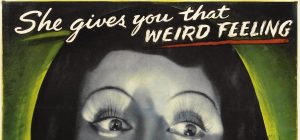
Frankenstein’s (1932) producers “Dare You To See It!”
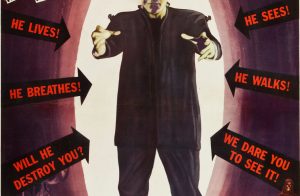
And, echoing the famous campaign for Jaws, the Suspiria (1977) poster threatens “You Will Never Again Feel Safe In The Dark.”
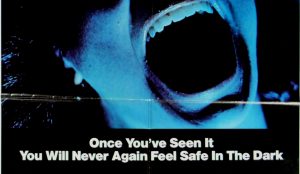
The exhibit’s showstopper, though, must be the poster for The Chamber of Horrors (1966), a film so intense it requires an “audio-visual warning system” to tell you when to “shut your eyes and hold your ears.”
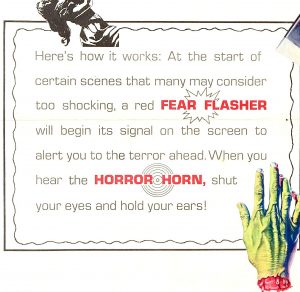
As this collection of posters attest, horror is the original exploitation genre. Could any movie be best enjoyed with closed eyes and covered ears? We dare you to find out!

